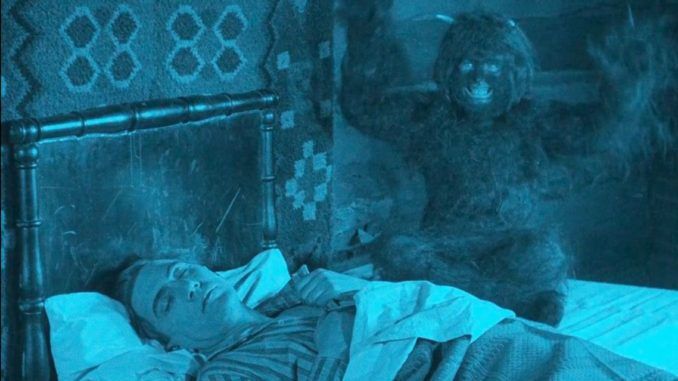
Rating: C+
Dir: Teuvo Puro
Star: Einar Rinne, Heidi Blåfield, Irmeli Viherjuuri, Kaisa Leppänen
This is believed to be Finland’s first locally produced horror movie, though some say that honour deserves to go to The Old Baron of Rautakylä, made four years earlier, qualifying as Gothic horror. Like most of these proto-genre efforts, you would need to squint a bit to see any connection to what we now know as horror. The witch in question is actually male, going by the name of Jantukka, and when he was captured and killed by a mob of angry villagers for practicing his craft, he laid down a curse of blindness on whoever occupied his lands. Generations later, that still seems to be in effect, with Elsa (Leppänen) afflicted by it. Though its impact thereafter is arguable: the ill events are very human.
Elsa is joined in the remote farmstead where she lives, by her brother, Simo (Rinne) and his new bride Selma (Blåfield), though he soon has to leave them to work. While he is gone, Selma goes out onto the lake to check their fishing nets, and is attacked by a leering lumberjack (the charmingly-named Fat Sakari) and, apparently, raped. Though this being the twenties, we just see her being chased ashore and off into the woods before the screen fades to black, and her husband’s sleep is tormented by a bizarre, demon-like visitor (top). I will say, the use of tinting in this movie is on point, going from almost blood red during the attack on Selma, to chilly blue for Simo’s dream. For a black-and-white film, it’s all surprisingly colourful.
 As well as Simo’s night terror and the witch’s curse, there are certainly dark elements, of revenge and familial loss in particular. He blames the curse for Selma’s post-traumatic stress, and she suspects him of involvement in the drowning death of their child, the product of the assault. Though Simo does not suspect it, until the similarity of “his” son to Fat Sakari are brought to his attention. Yeah, even at this early stage, Finnish cinema was living up to its contemporary reputation for gloom ‘n’ doom. However, it is all quite languid. If you’re hoping for a satisfactory helping of Scandinavian payback, you’ll be particularly disappointed, with Simo deciding to be the better man, and let legal justice prevail over vengeance.
As well as Simo’s night terror and the witch’s curse, there are certainly dark elements, of revenge and familial loss in particular. He blames the curse for Selma’s post-traumatic stress, and she suspects him of involvement in the drowning death of their child, the product of the assault. Though Simo does not suspect it, until the similarity of “his” son to Fat Sakari are brought to his attention. Yeah, even at this early stage, Finnish cinema was living up to its contemporary reputation for gloom ‘n’ doom. However, it is all quite languid. If you’re hoping for a satisfactory helping of Scandinavian payback, you’ll be particularly disappointed, with Simo deciding to be the better man, and let legal justice prevail over vengeance.
On the other hand, there is the lovely line: “Well, he’s been stabbed almost every year, but he hasn’t been done away with yet.” Could anything be more Finnish than that? You will see a good deal of lovely Scandinavian scenery, and it helps that the print I watched was in excellent shape, for a film almost one hundred years old. Although, oddly, it has no soundtrack at all – as with most silent films, I feel the accompanying music is a crucial element, to a greater degree than for movies with dialogue. It remains a solid film: while “horror” is a stretch, no more so than for many genre-adjacent entries coming out of other countries, and this is never less than a pleasure to look at.
